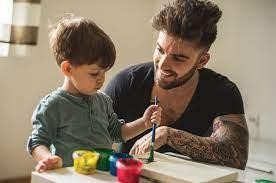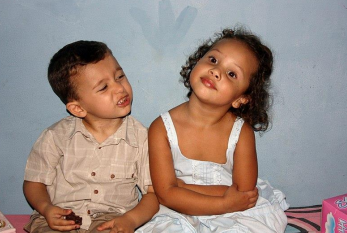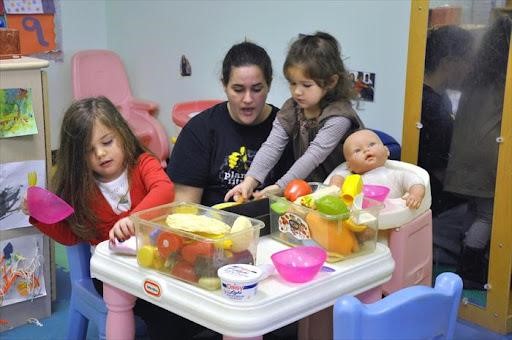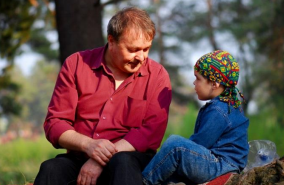11 Social Development in the Preschool Years
Chapter Objectives
After this chapter, you should be able to:
- Describe the continuum of development of social skills in preschoolers.
- Compare and contrast different styles of parenting.
- Discuss the role of siblings and peers.
- Describe the types of play.
- Discuss the development of social understanding in preschoolers.
- Summarize the influences on social and emotional competence.
Introduction
In the preschool years, children’s understanding of their role in the world expands greatly. Let’s examine some of the important interactions in social development between the ages of 2.5 and 6 years.
Continuum of Development
The Continuum of Development set out in Early Learning for Every Child Today: A framework for Ontario early childhood settings identifies several root social skills that are emerging in children between 2.5 and 6 years of age.
Seeking out and making friends gains importance during the preschool years. This is facilitated by improved skills in conflict resolution, social problem-solving skills, peer group entry skills and co-operation. Preschoolers are more competent at identifying emotions in others, taking another person’s point of view, empathizing and offering help. These emerging competencies improve the preschooler’s ability to interact with others positively and respectfully. Preschoolers often seek out adult attention and approval and have developed the social skills to do so in a positive manner (Ontario Ministry of Education, 2014).
Family Life
Relationships between parents and children continue to play a significant role in children’s development during early childhood. We will explore two models of parenting styles. Keep in mind that most parents do not follow any model completely. In reality, people tend to fall somewhere in between these styles. And sometimes parenting styles change from one child to the next or in times when the parent has more or less time and energy for parenting. Parenting styles can also be affected by concerns the parent has in other areas of their life. For example, parenting styles tend to become more authoritarian when parents are tired and perhaps more authoritative when they are more energetic. Sometimes, parents seem to change their parenting approach when others are around, maybe because they become more self-conscious as parents or are concerned with giving others the impression that they are a “tough” parent or an “easy-going” parent. And of course, parenting styles may reflect the type of parenting someone saw modelled while growing up.

Figure 11.1: A family playing outside together. (Image from Unsplash)
Indigenous Perspectives
Parenting styles are different in Indigenous people’s family life. For instance, in many nations, aunties and uncles are the ones who discipline the children to keep harmony in the home. Grandparents offer teachings and show cultural and traditional ways of life; they also sometimes discipline but in a different way.
Baumrind
Diana Baumrind (1971, as cited in Paris, Ricardo, Raymond, & Johnson, 2021) offers a model of parenting that includes four styles. The first, authoritarian, is the traditional model of parenting in which parents make the rules and children are expected to be obedient. Baumrind suggests that authoritarian parents tend to place maturity demands on their children that are unreasonably high and tend to be aloof and distant. Consequently, children reared in this way may fear rather than respect their parents and, because their parents do not allow discussion, may take out their frustrations on safer targets-perhaps as bullies toward peers.
Permissive parenting involves holding expectations of children that are below what could be reasonably expected from them. Children are allowed to make their own rules and determine their own activities. Parents are warm and communicative, but provide little structure for their children. Children fail to learn self-discipline and may feel somewhat insecure because they do not know the limits.
Authoritative parenting involves being appropriately strict, reasonable, and affectionate. Parents allow negotiation where appropriate and discipline matches the severity of the offense. In Ontario, many EarlyON Child and Family Centres offer parenting programs, including Triple P (Positive Parenting Program) and Nobody’s Perfect.
Uninvolved parents (also referred to as rejecting/neglecting) are disengaged from their children. They do not make demands on their children and are non-responsive. These children can suffer in school and in their relationships with their peers (Gecas & Self, 1991, as cited in Paris, Ricardo, Raymond, & Johnson, 2021).
Lemasters and Defrain
Lemasters and Defrain (1989, as cited in Paris, Ricardo, Raymond, & Johnson, 2021) offer another model of parenting. This model is interesting because it looks more closely at the motivations of the parent and suggests that parenting styles are often designed to meet the psychological needs of the parent rather than the developmental needs of the child.
The martyr is a parent who will do anything for the child; even tasks that the child should do for themself. All of the good deeds performed for the child, in the name of being a “good parent”, may be used later should the parent want to gain compliance from the child. If a child goes against the parent’s wishes, the parent can remind the child of all of the times the parent helped the child and evoke a feeling of guilt so that the child will do what the parent wants. The child learns to be dependent and manipulative as a result.
The pal is like the permissive parent described previously in Baumrind’s model. The pal wants to be the child’s friend. Perhaps the parent is lonely or perhaps the parent is trying to win a popularity contest against an ex-spouse. Pals let children do what they want and focus mostly on being entertaining and fun and set few limitations. Consequently, the child may have little self-discipline and may try to test limits with others.
The police officer/drill sergeant style of parenting is similar to the authoritarian parent described by Baumrind. The parent focuses primarily on making sure that the child is obedient and that the parent has full control of the child. Sometimes this can be taken to extreme by giving the child tasks that are really designed to check on their level of obedience. For example, the parent may require that the child fold the clothes and place items back in the drawer in a particular way. If not, the child might be scolded or punished for not doing things “right”. This type of parent has a very difficult time allowing the child to grow and learn to make decisions independently. And the child may have a lot of resentment toward the parent that is displaced on others.
The teacher-counselor parent is one who pays a lot of attention to expert advice on parenting and who believes that as long as all of the steps are followed, the parent can rear a perfect child. “What’s wrong with that?” you might ask. There are two major problems with this approach. First, the parent is taking all of the responsibility for the child’s behavior-at least indirectly. If the child has difficulty, the parent feels responsible and thinks that the solution lies in reading more advice and trying more diligently to follow that advice.
Parents can certainly influence children, but thinking that the parent is fully responsible for the child’s outcome is misguided. A parent can only do so much and can never have full control over the child. Another problem with this approach is that the child may get an unrealistic sense of the world and what can be expected from others. For example, if a teacher-counselor parent decides to help the child build self-esteem and has read that telling the child how special they are or how important it is to compliment the child on a job well done, the parent may convey the message that everything the child does is exceptional or extraordinary. A child may come to expect that all of their efforts warrant praise and in the real world, this is not something one can expect. Perhaps children get more of a sense of pride from assessing their own performance than from having others praise their efforts.

Figure 11.2: A father interacting with their son who is drawing a picture. He could be portraying the style of teacher-counselor or athletic coach. (Google Images)
So what is left? Lemasters and Defrain (1989, as cited in Paris, Ricardo, Raymond, & Johnson, 2021) suggest that the athletic coach style of parenting is best. Before you draw conclusions here, set aside any negative experiences you may have had with coaches in the past. The principles of coaching are what are important to Lemasters and Defrain. A coach helps players form strategies, supports their efforts, gives feedback on what went right and what went wrong, and stands at the sideline while the players perform. Coaches and referees make sure that the rules of the game are followed and that all players adhere to those rules. Similarly, the athletic coach as parent helps the child understand what needs to happen in certain situations whether in friendships, school, or home life, and encourages and advises the child about how to manage these situations. The parent does not intervene or do things for the child. Their role is to provide guidance while the child learns firsthand how to handle these situations. And the rules for behavior are consistent and objective and presented in that way. So, a child who is late for dinner might hear the parent respond in this way, “Dinner was at six o’clock.” Rather than, “You know good and well that we always eat at six. If you expect me to get up and make something for you now, you have got another thing coming! Just who do you think you are showing up late and looking for food? You’re grounded until further notice!”
The most important thing to remember about parenting is that you can be a better, more objective parent when you are directing your actions toward the child’s needs and while considering what they can reasonably be expected to do at their stage of development. Parenting is more difficult when you are tired and have psychological needs that interfere with the relationship. Some of the best advice for parents is to try not to take the child’s actions personally and be as objective as possible.
Indigenous Perspectives
First Nation parenting would likely fall under the athletic coach style of parenting in all aspects referred to in the textbook, with a twist. Each extended family members and some community members would play a different role. They would all help the player form strategies, support their efforts, give feedback on what went right and what went wrong (through teachings and storytelling), and stand at the sideline while the players perform. Elders and grandparents are the knowledge keepers that would give the teachings and guide the player (child) through storytelling. It is well known in our culture that children see themselves through the animal characters from the stories we use by which they learn values and lessons. Or they might choose a real-life story to help them learn a lesson.
Cultural Influences on Parenting Styles
The impact of class and culture cannot be ignored when examining parenting styles. The two models of parenting described above assume that authoritative and athletic coaching styles are best because they are designed to help the parent raise a child who is independent, self-reliant and responsible. These are qualities favored in “individualistic” cultures.
Canadian First Nation cultural groups, while diverse, all stress the critical importance of parenting during the first seven years. “In addition to parenting our children, we also are parenting our grandchildren, those yet to be born.” (Best Start Resource Centre, 2010 ). Parents, extended family, elders and the community are all responsible for providing unconditional love and discipline. Children are encouraged to make their own decisions (from among acceptable choices) and allowed to make mistakes. Story-telling is used to help teach children important life lessons. Modeling desirable behavior is another key teaching tool. First Nations cultures strongly believe that children are to be treated as equals and never talked down, belittled or bribed as a form of discipline.

Figure 11.3: A family from a collectivistic culture. (Image by the National Cancer Institute from Unsplash)
In “collectivistic” cultures such as China or Korea, being obedient and compliant are favored behaviors. Authoritarian parenting has been used historically and reflects cultural need for children to do as they are told. In societies where family members’ cooperation is necessary for survival, as in the case of raising crops, rearing children who are independent and who strive to be on their own makes no sense. But in an economy based on being mobile in order to find jobs and where one’s earnings are based on education, raising a child to be independent is very important.
Working class parents are more likely than middle class parents to focus on obedience and honesty when raising their children. In a classic study on social class and parenting styles called Class and Conformity, Kohn (1977, as cited in Paris, Ricardo, Raymond, & Johnson, 2021) explains that parents tend to emphasize qualities that are needed for their own survival when parenting their children. Working class parents are rewarded for being obedient, reliable, and honest in their jobs. They are not paid to be independent or to question the management; rather, they move up and are considered good employees if they show up on time, do their work as they are told, and can be counted on by their employers. Consequently, these parents reward honesty and obedience in their children.
Middle class parents who work as professionals are rewarded for taking initiative, being self-directed, and assertive in their jobs. They are required to get the job done without being told exactly what to do. They are asked to be innovative and to work independently. These parents encourage their children to have those qualities as well by rewarding independence and self-reliance. Parenting styles can reflect many elements of culture (Lumen Learning, n.d.).
Indigenous Perspectives
Due to the residential school legacy, laws have been put in place regarding the placement of children in non-indigenous families in foster care. For some but not all, the law states that the child will stay in the FN community whereby parents will go through cultural programming and healing to reintegrate the child back into the home. Also there is the issue of displacement for children from remote First Nation communities who do not have either elementary and/or secondary schools. Many grandparents or aunts and uncles decide to move out of the community to urban areas to take care of the children. Subsequently, other extended family members would be rearing the child/ren.
Changing Families in a Changing Society
The sociology of the family examines the family as an institution and a unit of socialization. Sociological studies of the family look at demographic characteristics of the family members: family size, age, ethnicity and gender of its members, social class of the family, the economic level and mobility of the family, professions of its members, and the education levels of the family members.
Currently, one of the biggest issues that sociologists study are the changing roles of family members. Often, each member is restricted by the gender roles of the traditional family. These roles, such as the father as the breadwinner and the mother as the homemaker, are declining. Now, the mother is often the supplementary provider while retaining the responsibilities of child rearing. In this scenario, females’ role in the labor force is “compatible with the demands of the traditional family.” Sociology studies the adaptation of males’ role to caregiver as well as provider. The gender roles are becoming increasingly interwoven.
Indigenous Perspectives
The same can be said about the roles of women in certain First Nations. Traditionally the men were the hunters; however, it is not uncommon today to see young women hunting with a male relative. Women have always had a major role to play in FN societies. Whether it is a matriarchal or patriarchal society, men have high regard for women. This view changed with colonization. The same can be said about women as the breadwinner (hunters).
Diverse Family Forms
A single parent family usually refers to a parent who has most of the day-to-day responsibilities in the raising of the child or children, who is not living with a spouse or partner, or who is not married. The dominant caregiver is the parent with whom the children reside the majority of the time. If the parents are separated or divorced, children might live with their custodial parent and have visitation with their noncustodial parent. In western society in general, following separation a child will end up with the primary caregiver, usually the mother, and a secondary caregiver, usually the father. Divorced or separated parents can also share custody, which often means that the child spends an equal amount of time with each parent. Family courts in Ontario will often work with a family to come up with a schedule that works for both parents, so that the child may spend certain days with each parent or they may have a week by week schedule.
There is a growing community of single parent by choice families in which a family is built by a single adult (through foster care, adoption, donor gametes and embryos, and surrogacy).

Figure 11.4: A single-parent family. (Image is in the Public Domain)
Cohabitation (also known as a common law relationship) is an arrangement where two people who are not married live together in an intimate relationship, particularly an emotionally and/or sexually intimate one, on a long-term or permanent basis. Today, cohabitation is a common pattern among people in the Western world. The 2016 Canadian census found common law couples make up 21.3% of all couples. Regional differences are significant. Quebec at 39.9%, Nunavut at 50.3%, Northwest Territories at 36.6% and Yukon at 31.9% were well above the average of 15.7% for the rest of Canada. (reference: Families, households and marital status (Statistics Canada, 2017a).
Gay and lesbian couples are categorized as same-sex relationships. Prior to 2005, cohabitation was the only choice for same-sex couples to live together in an intimate relationship in Canada. Same-sex marriage became legal in Canada in 2005 with the passage of the federal Civil Marriage Act. According to the 2016 Canadian census, same-sex couples represent 0.9% of all couples. Approximately 33% of those couples are married. The 2016 Canadian census also found that about 12% of same-sex couples (cohabitating or married) have children living with them (Statistics Canada, 2017b).

Figure 11.5: A family with parents of the same sex. (Image by Emily Walker is licensed under CC BY-SA 2.0)
Indigenous Perspectives
Traditionally, one of the roles of Two Spirit people (what society now refers to LGTBQ2S) was sometimes the rearing of the children for Medicine women.
Multigenerational Families
According to Statistics Canada, in 2011 approximately 600,000 grandparents aged 45 and older lived in the same household as their grandchildren. This represented about 8% of all grandparents in that age group. However, significant differences among cultural groups were found. 11% of grandparents who identified as Aboriginal (First Nations People, Metis or Inuit) lived with their grandchildren. This percentage increased to 22% in the Inuit population. 21% of recent immigrants to Canada (arriving between 2006 and 2011) aged 45 and older co-resided with grandchildren. These percentages are all significantly higher than the 3% of non-Indigenous Canadian-born grandparents who live in the same household as their grandchildren (Statistics Canada, 2015).
Today’s grandparent is healthier and will live longer than previous generations. While they may or may not co-reside with their grandchildren, many contribute to family life, perhaps choosing to provide child care or helping out financially. Evolving family composition has increased the need for non-parental child care. According to Statistics Canada (2015), in 2014, 69% of couples in Canada with children included 2 earners, up from just 36% in 1976. Likewise, the percentage of lone-parent families has increased from 1 in 10 in 1976 to approximately 1 in 5 in 2014.
Two factors can lead to grandparents being turned to for child care; lack of available, high quality, regulated child care and the cost. Availability varies among provinces and territories, but the need continues to far exceed availability across Canada. While there are many variables that go into the cost of child care (e.g.: urban versus rural, age of the child, centre-based versus home-based), as an example, “Ontario’s Early Years and Child Care Annual Report 2020” found median parent fees for licensed centre-based care ranged from $66/day for infants to $22/day for school-aged children (Province of Ontario, 2021). “Research shows that grandparent involvement in family life is significantly associated with child well-being, including greater prosocial behaviors and school involvement” (Vanier Institute, 2017). This is particularly true among First Nations families, where grandparents are valued for their role in supporting cultural well-being in younger generations.
Sibling Relationships
Siblings typically spend a considerable amount of time with each other and offer a unique relationship that is not found with same-age peers or with adults. Siblings play an important role in the development of social skills. Cooperative and pretend play interactions between younger and older siblings can teach empathy, sharing, and cooperation (Pike, Coldwell, & Dunn, 2005, as cited in Paris, Ricardo, Raymond, & Johnson, 2021) as well as negotiation and conflict resolution (Abuhatoum & Howe, 2013, as cited in Paris, Ricardo, Raymond, & Johnson, 2021). However, the quality of sibling relationships is often mediated by the quality of the parent-child relationship and the psychological adjustment of the child (Pike et al., 2005, as cited in Paris, Ricardo, Raymond, & Johnson, 2021). For instance, more negative interactions between siblings have been reported in families where parents had poor patterns of communication with their children (Brody, Stoneman, & McCoy, 1994, as cited in Paris, Ricardo, Raymond, & Johnson, 2021). Children who have emotional and behavioral problems are also more likely to have negative interactions with their siblings. However, the psychological adjustment of the child can sometimes be a reflection of the parent-child relationship. Thus, when examining the quality of sibling interactions, it is often difficult to tease out the separate effect of adjustment from the effect of the parent-child relationship.
While parents want positive interactions between their children, conflicts are going to arise, and some confrontations can be the impetus for growth in children’s social and cognitive skills. The sources of conflict between siblings often depend on their respective ages. Dunn and Munn (1987, as cited in Paris, Ricardo, Raymond, & Johnson, 2021) revealed that over half of all sibling conflicts in early childhood were disputes about property rights. By middle childhood this starts shifting toward control over social situations, such as what games to play, disagreements about facts or opinions, or rude behavior (Howe, Rinaldi, Jennings, & Petrakos, 2002, as cited in Paris, Ricardo, Raymond, & Johnson, 2021). Researchers have also found that the strategies children use to deal with conflict change with age, but that is also tempered by the nature of the conflict.
Abuhatoum and Howe (2013, as cited in Paris, Ricardo, Raymond, & Johnson, 2021) found that coercive strategies (e.g., threats) were preferred when the dispute centered on property rights, while reasoning was more likely to be used by older siblings and in disputes regarding control over the social situation. However, younger siblings also use reasoning, frequently bringing up the concern of legitimacy (e.g., “You’re not the boss”) when in conflict with an older sibling. This is a very common strategy used by younger siblings and is possibly an adaptive strategy in order for younger siblings to assert their autonomy (Abuhatoum & Howe, 2013, as cited in Paris, Ricardo, Raymond, & Johnson, 2021). A number of researchers have found that children who can use non-coercive strategies are more likely to have a successful resolution, whereby a compromise is reached and neither child feels slighted (Ram & Ross, 2008; Abuhatoum & Howe, 2013, as cited in Paris, Ricardo, Raymond, & Johnson, 2021).
Not surprisingly, friendly relationships with siblings often lead to more positive interactions with peers. The reverse is also true. A child can also learn to get along with a sibling, with, as the song says “a little help from my friends” (Kramer & Gottman, 1992, as cited in Lally & Valentine-French, 2019).

Figure 11.6: Siblings. (Image by LEONARDO DASILVA is licensed under CC BY 2.0)
Peers
Relationships within the family (parent-child and siblings) are not the only significant relationships in a child’s life. Peer relationships are also important. Social interaction with another child who is similar in age, skills, and knowledge provokes the development of many social skills that are valuable for the rest of life (Bukowski, Buhrmester, & Underwood, 2011, as cited in Paris, Ricardo, Raymond, & Johnson, 2021). In peer relationships, children learn how to initiate and maintain social interactions with other children. They learn skills for managing conflict, such as turn-taking, compromise, and bargaining. Play also involves the mutual, sometimes complex, coordination of goals, actions, and understanding. For example, as preschoolers engage in pretend play they create narratives together, choose roles, and collaborate to act out their stories. Through these experiences, children develop friendships that provide additional sources of security and support to those provided by their parents.

Figure 11.7: Navigating dramatic play provides great opportunities to continue to develop social skills with same-age peers. (Google Images)
However, peer relationships can be challenging as well as supportive (Rubin, Coplan, Chen, Bowker, & McDonald, 2011, as cited in Paris, Ricardo, Raymond, & Johnson, 2021). Being accepted by other children is an important source of affirmation and self-esteem, but peer rejection can foreshadow later behavior problems (especially when children are rejected due to aggressive behavior).
Peer relationships require developing very different social and emotional skills than those that emerge in parent-child relationships. They also illustrate the many ways that peer relationships influence the growth of personality and self-concept (Leon, n.d.).
Play
Freud saw play as a means for children to release pent-up emotions and to deal with emotionally distressing situations in a more secure environment. Vygotsky and Piaget saw play as a way of children developing their intellectual abilities (Dyer & Moneta, 2006, as cited in Paris, Ricardo, Raymond, & Johnson, 2021). Piaget created stages of play that correspond with the stages of cognitive development. The stages are:
Table 11.1: Piaget’s Stages of Play (Grounds for Play, n.d., as cited in Paris, Ricardo, Raymond, & Johnson, 2021).
| Stage | Description |
| Functional Play | Exploring, inspecting, and learning through repetitive physical activity. |
| Symbolic Play | The ability to use objects, actions, or ideas to represent other objects, actions, or ideas and may include taking on roles. (reference: Symbolic Play (n.d.). Retrieved from https://www.pgpedia.com/s/symbolic-play) |
| Constructive Play | Involves experimenting with objects to build things; learning things that were previously unknown with hands-on manipulations of materials. (reference: Constructive Play (n.d.). Retrieved from https://www.pgpedia.com/c/constructive-play) |
| Games with Rules | Imposes rules that must be followed by everyone that is playing; the logic and order involved forms that the foundations for developing game playing strategy (reference: Games with Rules (n.d.). Retrieved from https://www.pgpedia.com/g/games-rules) |
While Freud, Piaget, and Vygostsky looked at play slightly differently, all three theorists saw play as providing positive outcomes for children.
Mildred Parten (1932) observed two to five year-old children and noted six types of play. Three types were labeled as non-social (unoccupied, solitary, and onlooker) and three types were categorized as social play (parallel, associative, and cooperative). The table below describes each type of play. Younger children engage in non-social play more than those who are older; by age five associative and cooperative play are the most common forms of play (Dyer & Moneta, 2006, as cited in Paris, Ricardo, Raymond, & Johnson, 2021).
Table 11.2: Parten’s Classification of Types of Play (Lumen Learning, n.d., as cited in Paris, Ricardo, Raymond, & Johnson, 2021)
| Category | Description |
| Unoccupied Play | Children’s behavior seems more random and without a specific goal. This is the least common form of play. |
| Solitary Play | Children play by themselves, do not interact with others, nor are they engaging in similar activities as the children around them. |
| Onlooker Play | Children are observing other children playing. They may comment on the activities and even make suggestions, but will not directly join the play. |
| Parallel Play | Children play alongside each other, using similar toys, but do not directly act with each other |
| Associative Play | Children will interact with each other and share toys but are not working toward a common goal. |
| Cooperative Play | Children are interacting to achieve a common goal. Children may take on different tasks to reach that goal. |
Social Understanding
As we have seen, children’s experience of relationships at home and the peer group contributes to an expanding repertoire of social and emotional skills and also to broadened social understanding. In these relationships, children develop expectations for specific people (leading, for example, to secure or insecure attachments to parents), understanding of how to interact with adults and peers, and developing self-concept based on how others respond to them. These relationships are also significant forums for emotional development.
Remarkably, young children begin developing social understanding very early in life. Before the end of the first year, infants are aware that other people have perceptions, feelings, and other mental states that affect their behavior, and which are different from the child’s own mental states. Carefully designed experimental studies show that by late in the preschool years, young children understand that another’s beliefs can be mistaken rather than correct, that memories can affect how you feel, and that one’s emotions can be hidden from others (Wellman, 2011, as cited by Paris, Ricardo, Raymond, & Johnson, 2021). Social understanding grows significantly as children’s theory of mind develops.
How do these achievements in social understanding occur? One answer is that young children are remarkably sensitive observers of other people, making connections between their emotional expressions, words, and behavior to derive simple inferences about mental states (e.g., concluding, for example, that what Mommy is looking at is in their mind) (Gopnik, Meltzoff, & Kuhl, 2001, as cited in Paris, Ricardo, Raymond, & Johnson, 2021). This is especially likely to occur in relationships with people whom the child knows well, consistent with the ideas of attachment theory discussed above.

Figure 11.8: A father speaking to their child. (Image is in the public domain)
Growing language skills give young children words with which to represent these mental states (e.g., “mad,” “wants”) and talk about them with others. Thus in conversation with their parents about everyday experiences, children learn much about people’s mental states from how adults talk about them (“Your sister was sad because they thought Daddy was coming home.”) (Thompson, 2006b, as cited in Paris, Ricardo, Raymond, & Johnson, 2021).
Developing social understanding is based on children’s everyday interactions with others and their careful interpretations of what they see and hear. There are also some scientists who believe that infants are biologically prepared to perceive people in a special way, as organisms with an internal mental life, and this facilitates their interpretation of people’s behavior with reference to those mental states (Leslie, 1994, as cited in Paris, Ricardo, Raymond, & Johnson, 2021).
Social and Emotional Competence
Social and personality development is built from the social, biological, and representational influences discussed above. These influences result in important developmental outcomes that matter to children, parents, and society: a young adult’s capacity to engage in socially constructive actions (helping, caring, sharing with others), to curb hostile or aggressive impulses, to live according to meaningful moral values, to develop a healthy identity and sense of self, and to develop talents and achieve success in using them. These are some of the developmental outcomes that denote social and emotional competence.
These achievements of social and personality development derive from the interaction of many social, biological, and representational influences. Consider, for example, the development of conscience, which is an early foundation for moral development.
Conscience consists of the cognitive, emotional, and social influences that cause young children to create and act consistently with internal standards of conduct (Kochanska, 2002, as cited in Paris, Ricardo, Raymond, & Johnson, 2021). It emerges from young children’s experiences with parents, particularly in the development of a mutually responsive relationship that motivates young children to respond constructively to the parents’ requests and expectations. Biologically based temperament is involved, as some children are temperamentally more capable of motivated self-regulation (a quality called effortful control) than are others, while some children are more prone to the fear and anxiety that parental disapproval can evoke. The development of conscience is influenced by having a good fit between the child’s temperamental qualities and how parents communicate and reinforce behavioral expectations.
Conscience development also expands as young children begin to represent moral values and think of themselves as moral beings. By the end of the preschool years, for example, young children develop a “moral self” by which they think of themselves as people who want to do the right thing, who feel badly after misbehaving, and who feel uncomfortable when others misbehave. In the development of conscience, young children become more socially and emotionally competent in a manner that provides a foundation for later moral conduct (Thompson, 2012, as cited in Paris, Ricardo, Raymond, & Johnson, 2021).

Figure 11.9: This child might be experiencing a guilty conscience. (Image by George Hodan is in the is licensed under CC0 public domain)
Indigenous Perspective
Storytelling is used for this.
Summary
References
Best Start Resource Centre (2010). A child becomes strong: Journeying through each stage of the life cycle. Retrieved from http://docplayer.net/27962989-A-child-becomes-strong-journeying-through-each-stage-of-the-life-cycle.html.
Lally, M. & Valentine-French, S. (2019). Lifespan development: A psychological perspective (2nd ed.). Retrieved from http://dept.clcillinois.edu/psy/LifespanDevelopment.pdf
Leon, A. (n.d.). Children’s development: Prenatal through adolescent development. Retrieved from https://docs.google.com/document/d/1k1xtrXy6j9_NAqZdGv8nBn_I6-lDtEgEFf7skHjvE-Y/edit
Ontario Ministry of Education. (2014). Exerpts from “ELECT”. Retrieved from https://countrycasa.ca/images/ExcerptsFromELECT.pdf
Province of Ontario. (2021). Ontario’s early years and child care annual report 2020. Retrieved from https://www.ontario.ca/page/ontarios-early-years-and-child-care-annual-report-2020
Statistics Canada. (2017a). Families, households and marital status: Key results from the 2016 census. Retrieved from https://www150.statcan.gc.ca/n1/daily-quotidien/170802/dq170802a-eng.htm
Statistics Canada. (2017b). Same sex couples in Canada in 2016. Retrieved from https://www12.statcan.gc.ca/census-recensement/2016/as-sa/98-200-x/2016007/98-200-x2016007-eng.cfm
Statistics Canada. (2015). Study: Grandparents living with their grandchildren, 2011. Retrieved from https://www150.statcan.gc.ca/n1/en/daily-quotidien/150414/dq150414a-eng.pdf?st=qilY03R4
Vanier Institute. (2017). Grandparent health and family well-being. Retrieved from https://vanierinstitute.ca/grandparent-health-and-family-well-being/

